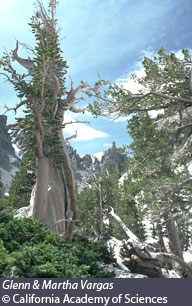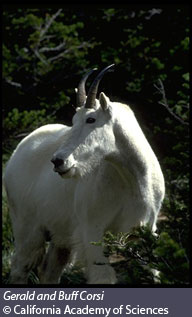|
Location | Weather | Plants | Animals | People | Links
 LOCATION:
What do you think of when you hear the word “alpine”? Perhaps mountains or skiing?
Well, you are right. Alpine biomes are found in mountain regions worldwide, including the
Andes, Alps, and Rocky Mountains. The alpine biome usually lies between an altitude of about
10,000 feet (3,000 meters), and the place where the snow line of a mountain begins. Combined, the Alpine
and Arctic biomes cover 16% of the earth's surface area. LOCATION:
What do you think of when you hear the word “alpine”? Perhaps mountains or skiing?
Well, you are right. Alpine biomes are found in mountain regions worldwide, including the
Andes, Alps, and Rocky Mountains. The alpine biome usually lies between an altitude of about
10,000 feet (3,000 meters), and the place where the snow line of a mountain begins. Combined, the Alpine
and Arctic biomes cover 16% of the earth's surface area.
WEATHER: In the summer average temperatures range
from 40 to 60°F (4.5 to 15.5°C). In the winter the temperatures are well below freezing. Generally,
as the altitude increases, the temperature gets colder. Temperatures in the alpine biome
are dynamic and can also change from warm to freezing in one day. The winter season lasts
from around October to May. The summer season may last from June to September. The alpine
biome is fairly dry with an average precipitation of 12 inches (30 cm) each year.
PLANTS: The alpine biome is a tough place for plants
to live. It’s windy, cold, and the sunlight at these high altitudes is very strong.
There are only about 200 species of alpine plants. At the high altitudes where these plants
live, there is very little carbon dioxide, which is necessary for plants to carry on photosynthesis.
Because of the blustery weather, most plants are small groundcover plants, which grow and
reproduce slowly. They protect themselves from the cold and wind by hugging close to the
ground. When plants die the cold weather makes it hard for them to decompose quickly. This
makes for poor soil conditions. Most alpine plants are adapted to grow in sandy and rocky
soil. Plants have also adapted to the dry conditions of the alpine biome. Some of the plants
found here are tussock grasses, small-leafed shrubs, and dwarf trees. The bristlecone pine
is an amazing plant of the alpine biome. It lives in scattered, arid mountain regions of
six western states of America ranging from Colorado to California. Many are found in the
Ancient Bristlecone Pine Forest in the White Mountains of California. These trees only grow
to about 60 feet (18 meters). That may seem tall, but for its age 60 feet (18 meters) is short! Bristlecone pines
can live to be over 4,000 years old. That is almost as old as the Great Sphinx of Ancient
Egypt!
 ANIMALS: Can you imagine living in a cold, windy place without much shelter? Animals that live in
the alpine biome must have special adaptations to survive the cold, snowy conditions. They
also have to deal with high UV light exposure from the sun and thin atmosphere. Mostly warm-blooded
animals live here, but a few types of insects also make the alpine biome home. Alpine animals
adapt to the cold by hibernating, migrating to warmer areas, or insulating their bodies
with layers of fat and fur. Their bodies tend to have shorter legs, tails, and ears, in
order to reduce heat loss. Alpine animals also have larger lungs, more blood cells, and
blood that can deal with the lower levels of oxygen at higher altitudes. Some animals in
the alpine biome are mountain goats, sheep, elk, beetles, grasshoppers and butterflies.
Which of these animals do you think leaves the alpine biome in the winter? ANIMALS: Can you imagine living in a cold, windy place without much shelter? Animals that live in
the alpine biome must have special adaptations to survive the cold, snowy conditions. They
also have to deal with high UV light exposure from the sun and thin atmosphere. Mostly warm-blooded
animals live here, but a few types of insects also make the alpine biome home. Alpine animals
adapt to the cold by hibernating, migrating to warmer areas, or insulating their bodies
with layers of fat and fur. Their bodies tend to have shorter legs, tails, and ears, in
order to reduce heat loss. Alpine animals also have larger lungs, more blood cells, and
blood that can deal with the lower levels of oxygen at higher altitudes. Some animals in
the alpine biome are mountain goats, sheep, elk, beetles, grasshoppers and butterflies.
Which of these animals do you think leaves the alpine biome in the winter?
One interesting alpine animal is the chinchilla. Maybe you’ve seen one of these small, gray, furry creatures in a nature center or zoo. In the wild, chinchillas live in the Andes alpine regions, but they are not easily found. Chinchillas are herbivores. Their diet in the wild consists of plants, roots, and grasses. As altitude increases, the temperature decreases, so in these regions the chinchilla has even denser fur. Chinchillas used to be hunted for their soft, beautiful fur. People used their pelts to make coats until they became nearly extinct in the 1940s. It takes over 100 pelts to make one chinchilla coat! Now they are on the endangered species list, and protected by law from hunting and people. The snowshoe rabbit and ptarmigan bird are also alpine animals. They are adapted to be less visible when snow covers the ground through camouflage. The showshoe rabbit has brown fur in the summer, but in the winter it turns white. What do you think the ptarmigan does to camouflage? It’s like the snowshoe hare! In the summer the ptarmigan has brown feathers and in the winter its feathers are white to hide in the snowy environment.
PEOPLE AND THE ALPINE BIOME: You’ve probably
heard of mount Everest and the Sherpas who help people climb it. The Sherpas are naturally
born mountaineers! They live in the Himalayas and are the world’s highest living population.
They are physically adapted to live in the alpine biome. Sherpas have larger lungs and more
hemoglobin in their blood to cope with the increased pressure and lack of oxygen at high altitudes.
The Indians of the Andes Mountains in South America have also adapted to living in the alpine
biome.
LINKS:
Blue Planet Biomes: Alpine
GF Awesome: Subalpine Ecosystems
Back to Biomes Index |

